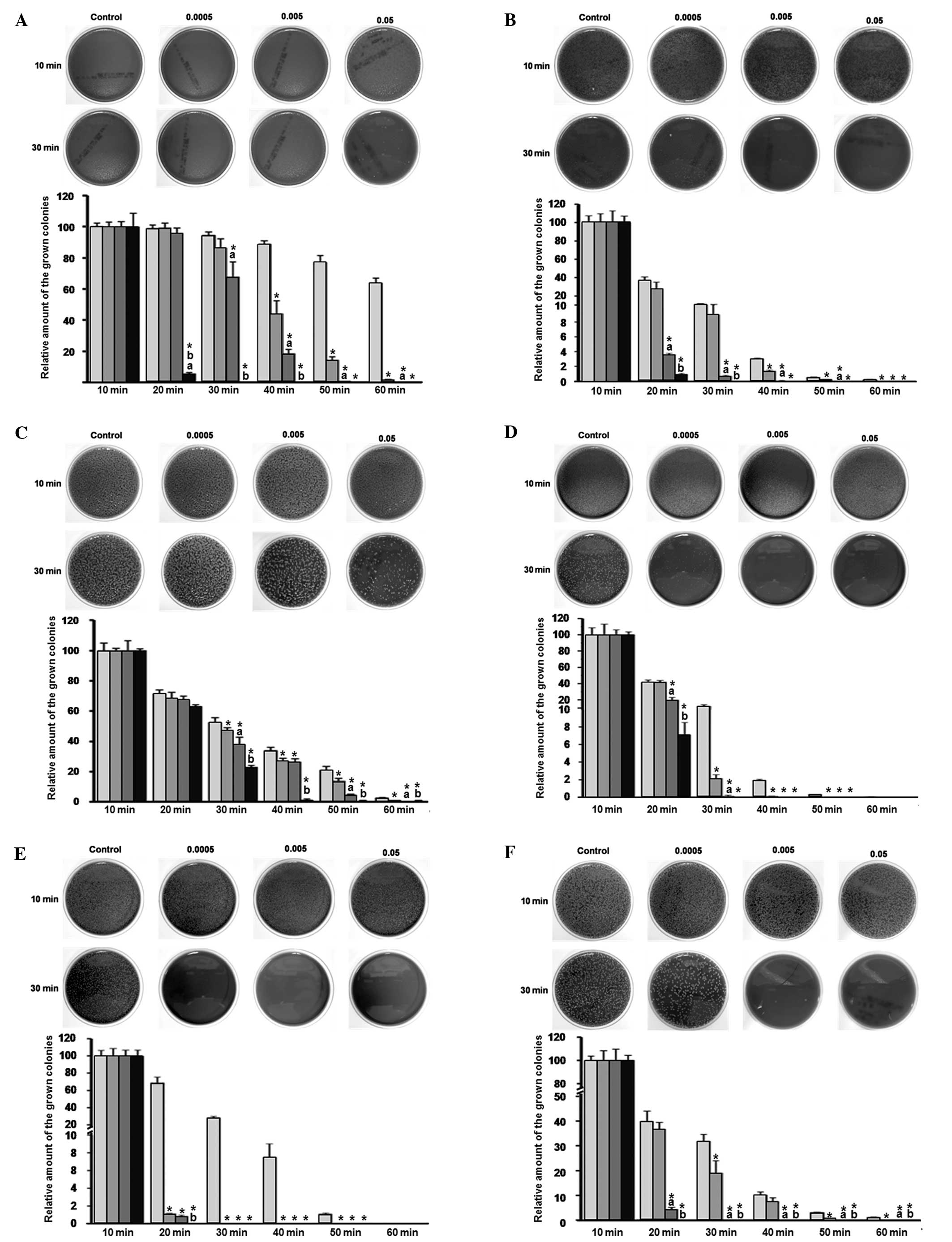|
1
|
Harkenthal M, Reichling J, Geiss HK and
Saller R: Comparative study on the in vitro antibacterial activity
of Australian tea tree oil, cajuput oil, niaouli oil, manuka oil,
kanuka oil, and eucalyptus oil. Pharmazie. 54:460–463.
1999.PubMed/NCBI
|
|
2
|
Carson CF, Cookson BD, Farrelly HD and
Riley TV: Susceptibility of methicillin-resistant Staphylococcus
aureus to the essential oil of Melaleuca alternifolia. J
Antimicrob Chemother. 35:421–424. 1995.PubMed/NCBI
|
|
3
|
Aziz NH, Farag SE, Mousa LA and Abo-Zaid
MA: Comparative antibacterial and antifungal effects of some
phenolic compounds. Microbios. 93:43–54. 1998.PubMed/NCBI
|
|
4
|
Basaga H, Poli G, Tekkaya C and Aras I:
Free radical scavenging and antioxidative properties of ‘silibin’
complexes on microsomal lipid peroxidation. Cell Biochem Funct.
15:27–33. 1997.
|
|
5
|
Jaime L, Mendiola JA, Herrero M, et al:
Separation and characterization of antioxidants from Spirulina
platensis microalga combining pressurized liquid extraction,
TLC, and HPLC-DAD. J Sep Sci. 28:2111–2119. 2005.PubMed/NCBI
|
|
6
|
Jones RC, Hughes CR, Wright D and Baumer
JH: Early house moves, indoor air, heating methods and asthma.
Respir Med. 93:919–922. 1999. View Article : Google Scholar : PubMed/NCBI
|
|
7
|
Vincent D, Annesi I, Festy B and Lambrozo
J: Ventilation system, indoor air quality, and health outcomes in
Parisian modern office workers. Environ Res. 75:100–112. 1997.
View Article : Google Scholar : PubMed/NCBI
|
|
8
|
O'Connor GT: Allergen avoidance in asthma:
what do we do now? J Allergy Clin Immunol. 116:26–30. 2005.
View Article : Google Scholar
|
|
9
|
Vaughan JW, Woodfolk JA and Platts-Mills
TA: Assessment of vacuum cleaners and vacuum cleaner bags
recommended for allergic subjects. J Allergy Clin Immunol.
104:1079–1083. 1999. View Article : Google Scholar : PubMed/NCBI
|
|
10
|
Gore RB, Durrell B, Bishop S, Curbishley
L, Woodcock A and Custovic A: High-efficiency particulate
arrest-filter vacuum cleaners increase personal cat allergen
exposure in homes with cats. J Allergy Clin Immunol. 111:784–787.
2003. View Article : Google Scholar : PubMed/NCBI
|
|
11
|
Haysom IW and Sharp K: The survival and
recovery of bacteria in vacuum cleaner dust. J R Soc Promot Health.
123:39–45. 2003. View Article : Google Scholar : PubMed/NCBI
|
|
12
|
Shishido H, Nagai H and Kawakami K: MRSA
respiratory tract infection. Nihon Rinsho. 50:1075–1080.
1992.PubMed/NCBI
|
|
13
|
Odagiri S: Respiratory tract infections
caused by MRSA. Nihon Naika Gakkai Zasshi. 81:1620–1628.
1992.PubMed/NCBI
|
|
14
|
Hogt AH, Dankert J and Feijen J: Adhesion
of coagulase-negative staphylococci to methacrylate polymers and
copolymers. J Biomed Mater Res. 20:533–545. 1986. View Article : Google Scholar : PubMed/NCBI
|
|
15
|
Hong EJ, Na KJ, Choi IG, Choi KC and Jeung
EB: Antibacterial and antifungal effects of essential oils from
coniferous trees. Biol Pharm Bull. 27:863–866. 2004. View Article : Google Scholar : PubMed/NCBI
|
|
16
|
Park MJ, Gwak KS, Yang I, et al:
Antifungal activities of the essential oils in Syzygium
aromaticum (L.) Merr. Et Perry and Leptospermum
petersonii Bailey and their constituents against various
dermatophytes J Microbiol. 45:460–465. 2007.PubMed/NCBI
|
|
17
|
Joo SS, Yoo YM, Ko SH, et al: Effects of
essential oil from Chamaecypris obtusa on the development of
atopic dermatitis-like skin lesions and the suppression of Th
cytokines. J Dermatol Sci. 60:122–125
|
|
18
|
Singh G, Kapoor IP, Pandey SK, Singh UK
and Singh RK: Studies on essential oils: part 10; antibacterial
activity of volatile oils of some spices. Phytother Res.
16:680–682. 2002. View
Article : Google Scholar : PubMed/NCBI
|
|
19
|
Prabuseenivasan S, Jayakumar M and
Ignacimuthu S: In vitro antibacterial activity of some plant
essential oils. BMC Complement Altern Med. 6:392006. View Article : Google Scholar : PubMed/NCBI
|
|
20
|
Hongratanaworakit T: Aroma-therapeutic
effects of massage blended essential oils on humans. Nat Prod
Commun. 6:1199–1204
|
|
21
|
Ng QY, Lee KW, Byrne C, Ho TF and Lim CL:
Plasma endotoxin and immune responses during a 21-km road race
under a warm and humid environment. Ann Acad Med Singapore.
37:307–314. 2008.PubMed/NCBI
|
|
22
|
Ogawa Y, Kuwana M, Yamazaki K, et al: Dry
eye associated with chronic graft-versus-host disease. Adv Exp Med
Biol. 506:1041–1045. 2002. View Article : Google Scholar : PubMed/NCBI
|
|
23
|
No authors listed. Indoor air quality.
Schriftenr Ver Wasser Boden Lufthyg. 53:1–439. 1982.
|
|
24
|
Buckland FE and Tyrrell DA: Loss of
infectivity on drying various viruses. Nature. 195:1063–1064. 1962.
View Article : Google Scholar : PubMed/NCBI
|
|
25
|
Moe K and Shirley JA: The effects of
relative humidity and temperature on the survival of human
rotavirus in faeces. Arch Virol. 72:179–186. 1982. View Article : Google Scholar : PubMed/NCBI
|
|
26
|
Couch RB: Viruses and indoor air
pollution. Bull NY Acad Med. 57:907–921. 1981.PubMed/NCBI
|
|
27
|
Arundel AV, Sterling EM, Biggin JH and
Sterling TD: Indirect health effects of relative humidity in indoor
environments. Environ Health Perspect. 65:351–361. 1986.PubMed/NCBI
|
















